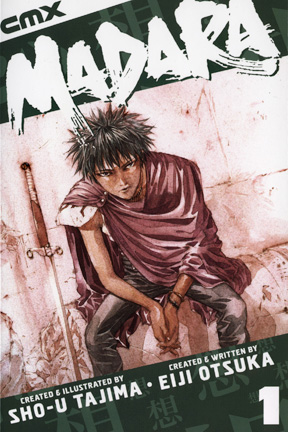
Pick your fantasy,
social or visceral
We love our fantasies. Whether they be fantastic fantasies, sci-fi fantasies or slightly more realistic fantasies (government conspiracies, anyone?), there's no doubt that such flights of fancy strike some chord within us -- escapism, hope or dread for the future.
The CMX manga "Musashi #9" by Miyuki Takahashi falls within that third category. This collection of spy and terrorist stories involves an ultracovert organization rumored to be so powerful, it's known as "the other United Nations." (And for the political pessimists for whom being linked to the U.N. means next to nothing, keep in mind this manga was first written in 1996.)
Very little is known about this worldwide organization other than its name, Ultimate Blue, and that all their agents, from children to old men, are top-notch. Out of all these agents, the top nine have been said to have the ability to change the course of history.
"Musashi #9" focuses on -- who else? -- Agent No. 9, code-named Musashi. In the first tale (called "missions" here -- Japanese anime and manga creators come up with some great names other than "episode" and "chapter" to describe said items), the agent is enlisted to protect a brash high school girl, Yayoi, who unknowingly is the key to changing the world's political landscape. How does Musashi do this? By posing as a transfer student.
Yes, Musashi is only 16 years old.
Wearing an almost flamboyant (but, as we see later, also frighteningly functional) cape, heavy combat boots and long hair tied back in a loose ponytail, the agent sticks out like a sore thumb in the school. That doesn't diminish Musashi's effectiveness, however -- the men out to kill Yayoi have no idea why their attempts at gunning the girl down or running her over on the street fail when all they can see around is teenagers.
Despite the danger (or perhaps because of it), Yayoi starts falling for her aloof protector. But the agent insists things wouldn't work between them.
When the mission comes to its end, Musashi shows up to school for just one more day, finally wearing the school uniform. With a skirt.
Yes, Musashi is a girl.
Musashi is the typical character favored in spy stories -- she's deadly efficient, calm and collected, and confident in her abilities, but with just a hint of feminine sensitivity beneath it all. As such, you can't help but wonder what the story behind her is, especially when you consider that she's been an Ultimate Blue agent since she was 10 years old.
"Musashi" is the kind of series that, in an era in which stories about espionage and super-secret organizations are a dime a dozen, might not prove impressive at first. But the mysterious nature of Musashi and Ultimate Blue is exactly what the manga has going for it: Each mission reveals just a little bit more how powerful and wide-ranging UB is and how much Musashi can kick ... well, just how lethal Musashi's skills are.
The story also takes an unusual philosophical view. While the overall theme is "save the world," it's really the people who make up that world that are the focus. Musashi is often called on to protect average citizens, oftentimes high school students who lead ordinary lives until they became unwittingly embroiled in some political struggle. This perspective alone is enough to make the series worth reading.

Villagers in remote Hijura find a badly injured baby boy floating down from Mount Shumi on a lotus flower. The village elder, sensing the infant's strong aura and possible fate, heals him by replacing his body with so-called "gadgets" -- mechanical parts that effectively turn the boy into a cyborg.
When the boy, Madara, turns 15, Elder Tatara fits him with special gadgets just before the village is attacked by demon soldiers of Kongo, who have come to claim the land for the evil Emperor Miroku. Tatara gives Madara the means to tap into the hidden power of his gadgets, and the boy turns into a war weapon, his punches ripping clean through the soldiers' bodies.
The battle is the end of Madara's peaceful life in Hijura and the beginning of his destiny. Tatara, fatally injured in a later fight against one of Miroku's eight generals, tells the boy he must seek out his true body, which was cut into pieces and given to the generals to hide Madara's power.
As Madara begins his journey with his childhood friend Kirin in tow, he hears tales of a warrior destined to lead mankind to the holy land of Agartha. Parts of the legend from different tribes are also told in text snippets at the beginning of each chapter.
With his coming on the lotus and a dragon crest appearing on his forehead when his battle gadgets are activated, Madara is believed to be that hero and is aided by various people along the way.
"Madara" is incredibly violent, with the title character's hotheaded nature spilling into his desire for revenge and guiding him to brutal, bloody deeds. Heads are crushed, chests explode, bodies are sliced into pieces. If you can't stomach that, stay far away from this series and its corresponding anime. (The four-episode anime was released on DVD in 2003 by Media Blasters.)
In a departure from traditional Japanese manga, artist Tajima and writer Otsuka made their artwork flow Western-style, from left to right. CMX provides a note at the end of the book to explain this.
[News] [Business] [Features] [Sports] [Editorial] [Do It Electric!]
[Classified Ads] [Search] [Subscribe] [Info] [Letter to Editor]
[Feedback]
